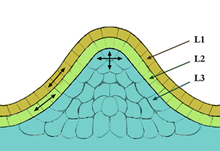
In biology, a tunica (/ˈt(j)uːnɪkə/,[1] UK: /ˈtʃuːnɪkə/; pl.: tunicae) is a layer, coat, sheath, or similar covering. The word came to English from the Neo-Latin of science and medicine. Its literal sense is about the same as that of the word tunic, with which it is cognate. In biology, one of its senses used to be the taxonomic name of a genus of plants, but the nomenclature has been revised and those plants are now included in the genus Petrorhagia.
In modern biology in general, tunica occurs as a technical or anatomical term mainly in botany and zoology. It usually refers to membranous structures that line or cover particular organs. In many such contexts, tunica is used interchangeably with tunic according to preference. An organ or organism that has a tunic(a) may be said to be tunicate, as in a tunicate bulb. This adjective tunicate is not to be confused with the noun tunicate, which refers to a member of the subphylum Tunicata.
- ^ "tunica". Dictionary.com Unabridged (Online). n.d.